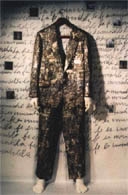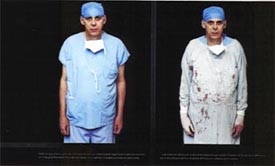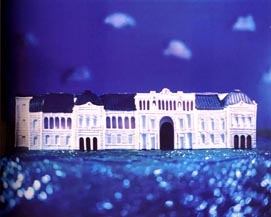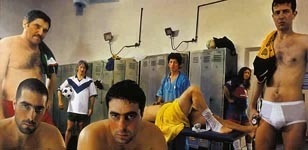Feature: Reviews
The Argentine Scene
By Luciana Sario
Buenos Aires Catharsis
The Argentine artistic scene is coming to life again, little by little, more than a year after the economic and political crisis that was one of the most critical moments of Argentine history.
At the end of 2002, the Second Buenos Aires Biennial, featuring 180 artists from 45 countries, was organized by the National Museum of Fine Arts, under the management of art critic Jorge Glusberg. Despite the sociopolitical disruptions, the biennial was able to provide a broad selection of works ranging from paintings to photography and video art to installations. A number of remarkable personalities of the contemporary art world, such as American Dennis Oppenheim, Spaniard Antoni Muntadas, Ukrainian Ilya Kabakov and Israeli Uri Katzenstein, were represented, but the surprise stars of the show were Latin American artists whose works refer to the social, political and economic realities in their countries. Among them was Tomás Espinosa, whose work June 26, 2002/The Executed Men relates to the violence and horror suffered over the last months in Argentina. Using gunpowder as paint, Espinosa refigured a scene of violence that appeared in a city newspaper last June. Paraguayan artist Adriana Gonzales Brun weighed in with a powerful installation entitled Memory of a File, in which she alludes to the people who disappeared during the military regimes in Latin America. The work is based on the files discovered in Paraguay after the fall of the dictatorship, bringing to light the systematic repression and violation of human rights in her country. Peruvian artist Eduardo Tokeshi, whose works showcase a heavy conceptual burden generally related to Peruvian customs and beliefs, exhibited on this occasion an installation entitled The Great Dream, inviting the spectator to create his own dream or nightmare.
The Museum of Fine Arts also hosted the Awards of the Banco Ciudad Foundation, which has consolidated itself in its second year of existence as one of the key events for the promotion of Argentine artists. With the participation of 120 artists, this award manages to show an exhaustive synthesis of today’s art in Argentina. The first prize was awarded to the artist Res, who has been working for more than two decades, for his work entitled Jorge Trainini, Heart Surgeon. In this work, he explores the relationship of notions of time and truth to thought and political thinking. In his duplicated portraits, he plays with the transformations of the past and the present, and metamorphoses that destabilize closed constructions of reality. The second prize went to Tomás Espinosa for 26 June, 2002 which was also exhibited in the Second Biennial. Ananké Assef received a honorary mention for her colored untitled photograph, taken in 2001. The image features Assef sitting in the middle of a white sofa wearing a school uniform and holding a box closed with wire tapes bearing the message “Do not violate.” Referring to the regime’s many attacks on students and assaults on women, the work opposes perversion with irony and ingenuity. Another important contribution was made by Fabiana Barreda with her work Casa Rosada, featuring a replica of the presidential house made of sugar, symbolizing the fragility of the political system in Argentina.
Another exhibition, directly related to the social situation in Argentina, was curated by Rafael Cippolini at the Latin American Museum of Buenos Aires, Malba. Cippolini gathered three different artists, the DOMA group and photographers Mumi and Guillermo Ueno, to work on the issue of violence and insecurity in Argentina. Through photographs and installations, the artists recreated an episode where a fifteen-year-old boy is murdered near a lake in the surroundings of Buenos Aires. When entering the exhibition, one seems to be going into a controlled area, watched over and “protected” by a security company. Boards, signs and projections send messages of caution and danger such as “Your well-being is our business,” and “Caution: It is important to be conscious of the historical moment we are living.”
The Proa Foundation organized a group exhibition named Anxiety and Devotion aimed at analyzing the Argentinean artistic response to the crisis unleashed last December 2001. Their proposals explore the contemporary political, social, economic and cultural scenes in an intent to reflect on Argentinean reality, going beyond temporary, disciplinary and aesthetic constraints and limitations, by exploring history, myths and collective memory.
On the gallery circuit, the situation was fairly calm, since during the summer months of December, January and February most people, in spite of the crisis, still go on vacation. Among the most interesting exhibitions, we should mention the Alicia Herrero’s iron work at the Louisa Pedrouzo Gallery. The exhibition’s walls were covered with reflective foil, leading us to ponder the visual hierarchy with which we organize our perceptions of objects and their surroundings.
As far as the future is concerned, an exhibition of the Argentinian artist Guillermo Kuitca organized by the Reina Sofia Museum – Museo Nacional Centro de Arte Reina Sofia and the Latin American Museum of Fine Arts – MALBA is eagerly anticipated. Both museums will jointly present his first retrospective. The retrospective is also Kuitca’s first exhibition in Argentina after many years of absence. The exhibition is currently on view at the Reina Sofia Museum and will be coming to Buenos Aires in April.




